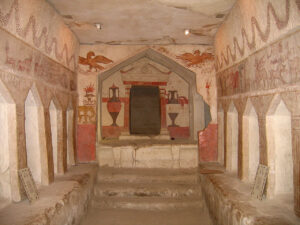
Beit Guvrin Burial Cave. By Talmoryair – Own work, CC BY 3.0, https://commons.wikimedia.org/w/index.php?curid=7393305
A parade of exotic and mythical beasts can now be seen in Beth Guvrin National Park, near Lachish, about 23 miles southwest of Jerusalem. Griffins, leopards, lions, giraffes, hippopotami, rhinoceri, alligators, tapirs and fish with elephant and rhinoceros faces march across the walls of one of the recently restored Hellenistic burial caves in the Mareshah part of the park. Drawings published in 1905 guided the Israel Antiquities Authority’s restoration of the badly defaced and faded cave paintings, which show the influence of Semitic, Ptolemaic, Persian, Assyrian and Egyptian imagery.
Discovered at the turn of the century, the cave paintings decorate the first of the seven tombs whose wall paintings and more than 30 inscriptions, including a love poem, date to the Seleucid period (196–119 B.C.). Of particular note are the names inscribed in these tombs. The fathers’ names are generally Semitic, but the sons’ names are Greek, suggesting assimilation of this colony from Sidon into the Hellenized local population. The other burial caves resemble Ptolemaic ones found at Alexandria and Hellenistic Phoenician caves.
Read the rest of BARlines: Wall Paintings Restored at Mareshah in the online Biblical Archaeology Society Library.